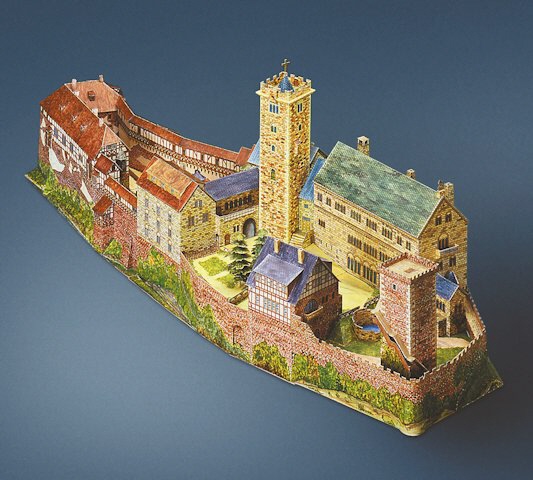Wartburg Castle

German title: Wartburg
Scale: 1:250
Length: 72 cm
Width: 22 cm
Height: 21 cm
Degree of difficulty: 3 (difficult)
Number of sheets: 9
THE WARTBURG
In the 11 th century, Landgrave Ludwig of Thuringia had a castle built on a 400m-high rock near the town of Eisenach. The name of the present Wartburg is said to go back to an alleged cry of the landgrave: "Wait, ("Wart") rock, you will bear me a castle ("Burg")". Since then the Wartburg was the seat of the Thuringian court which was considered to be the centre of knightly poetic art at the beginning of the 13th century. During this time, according to a legend, the so-called "Singers' war on the Wartburg" is said to have taken place. People who played an important role in history and religion were inhabitants of the Wartburg. Elisabeth of Thuringia lived from 1211 – 1228 on the Wartburg. She was married to Landgrave Ludwig IV. Because of her self-imposed ascetic way of life and her commitment to the poor, she threw the aristocratic court into a turmoil and had to leave the castle after her husband's death. Already four years after her death she was canonized. About three hundred years later Martin Luther was hidden on the Wartburg. Before that he had been banned because of his criticism of the church and outlawed. He adopted the name "Junker Jörg", and during his stay he translated the New Testament from the Greek language into German. He lived in the Bailiwick which, for this reason is today also called the "Luther House". The Luther Room can still be visited today.
In the middle of the 19th century as well as in the 50s of the 20th century, extensive restoration work was done on the Wartburg. Through the many replenishments in the course of the centuries, many different architectural styles from the Romanesque, Gothic and Renaissance periods can be found on the Wartburg. One can understand the original condition of the castle through drawings done by Johann Wolfgang von Goethe during a visit to the Wartburg. The castle complex was originally built in the shape of a ring. In the 14th and 15th centuries the battlements Margarethengang and Elisabethgang were added to the former ring wall. The Bailiwick and the Knights' House connect to the Margarethengang. Both buildings originate from the 15th century. This building complex is also called the Front Castle. The middle part of the castle reaches from the Gate Hall to the Large Tower, also called Keep. It was built in the 19th century on the foundations of earlier buildings. In the actual Hofburg there is the "Palas" from the 12th century. It served the landgrave as a representing and residential building and is today one of the best preserved buildings of the Romanesque period. Today it houses the museum. The Knights' Bath and the Guesthouse from the 19th century and the South Tower, also called Gunpowder Tower, from the 14th century also belong to the Hofburg. The long drawn-out, somewhat irregular way of building of the Wartburg is very impressive to the present day. Ludwig II of Bavaria was inspired by the castle when he planned the building of Neuschwanstein Castle in the middle of the 19th century. In 1999 the UNESCO appointed the castle as "World Heritage of Mankind" and in doing so not only acknowledged its varied architecture, but also its great historical importance.
